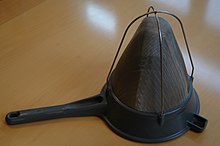Chinois

A chinois (UK: /ˈʃɪnwɑː, ˈʃiːnwɑː/ SHIN-wah, SHEE-nwah, US: /ʃiːˈnwɑː/ shee-NWAH, French: [ʃinwa] ), also known as a bouillon strainer, is a conical sieve with an extremely fine mesh. It is used to strain custards, purees, soups, and sauces, producing a very smooth texture. It can also be used to dust food with a fine layer of powdered ingredient.[1][2][3]
Etymology
[edit]Chinois is a loanword from the French adjective meaning 'Chinese'. French cooks call it this not because this kitchen tool comes from China but because it resembles an Asian conical hat.[4]
Comparison with the China Cap
[edit]
A similarly shaped utensil is the China cap (also named for its resemblance to Asian conical hats). It is a perforated metal conical strainer with much larger holes than a chinois. A China cap is used to remove seeds and other coarse matter from soft foods, but produces a coarser-textured product than the chinois.[5]
Both the chinois and the China cap often are used with a cone-shaped pestle. With the pestle tip placed in the bottom of the strainer, it is rolled against the sides of the device to work liquids and soft food through it. In this way, the chinois functions much like a tamis and the China cap, a food mill. A small ladle is also sometimes used instead of a pestle. This allows the user to scoop solids from the sides of the strainer as well as pressing liquid through the mesh.
See also
[edit]References
[edit]- ^ Alfaro, Danilo. "Chinois: Definition". About.com. Archived from the original on 11 January 2014. Retrieved 4 December 2013.
- ^ "Chinois | Resource". Smartkitchen.com. Smart Kitchen Online Cooking School. Archived from the original on 11 January 2014. Retrieved 4 December 2013.
- ^ Kimball, Christopher (July 2012). "Chinois Sieves Review". Cook's Illustrated (July 2012). Retrieved 4 December 2013.
- ^ "CHINOIS : Définition de CHINOIS". www.cnrtl.fr. Retrieved 2023-11-20Definition 3B1
{{cite web}}: CS1 maint: postscript (link) - ^ "buykitchenstuff.com - Best Kitchen and Cooking Stuff". BuyKitchenStuff. Retrieved 2023-11-20.
External links
[edit] The dictionary definition of chinois at Wiktionary
The dictionary definition of chinois at Wiktionary

